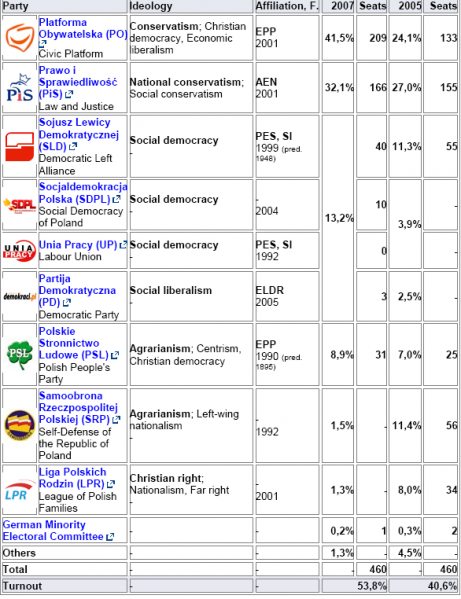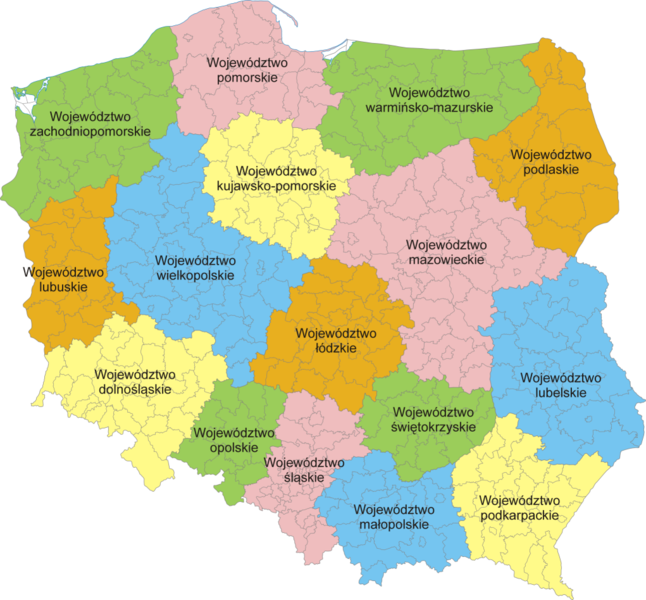Poland is a democracy, with a President as a Head of State, whose current constitution dates from 1997. The government structure centres on the Council of Ministers, led by a prime minister. The president appoints the cabinet according to the proposals of the prime minister, typically from the majority coalition in the Sejm. The president is elected by popular vote every five years. The current president is Lech Kaczyński, the current prime minister is Donald Tusk.
Polish voters elect a bicameral parliament consisting of a 460-member lower house (Sejm) and a 100-member Senate (Senat). The Sejm is elected under proportional representation according to the d’Hondt method, a method similar to that used in many parliamentary political systems. The Senate, on the other hand, is elected under a rare plurality bloc voting method where several candidates with the highest support are elected from each constituency. With the exception of ethnic minority parties, only candidates of political parties receiving at least 5% of the total national vote can enter the Sejm. When sitting in joint session, members of the Sejm and Senate form the National Assembly (the Zgromadzenie Narodowe). The National Assembly is formed on three occasions: when a new President takes the oath of office; when an indictment against the President of the Republic is brought to the State Tribunal (Trybunał Stanu); and when a President’s permanent incapacity to exercise his duties due to the state of his health is declared. To date, only the first instance has occurred.
The judicial branch plays an important role in decision-making. Its major institutions include the Supreme Court of Poland (Sąd Najwyższy); the Supreme Administrative Court of Poland (Naczelny Sąd Administracyjny); the Constitutional Tribunal of Poland (Trybunał Konstytucyjny); and the State Tribunal of Poland (Trybunał Stanu). On the approval of the Senate, the Sejm also appoints the Ombudsman or the Commissioner for Civil Rights Protection (Rzecznik Praw Obywatelskich) for a five-year term. The Ombudsman has the duty of guarding the observance and implementation of the rights and liberties of Polish citizens and residents, of the law and of principles of community life and social justice
Last national elections 2007

http://www.parties-and-elections.de/poland.html
Last European Parliament election June 2009 See: • http://www.europarl.europa.eu/parliament/archive/elections2009/en/poland_en.html • http://en.wikipedia.org/wiki/European_Parliament_election,_2009_(Poland) • http://www.telegraph.co.uk/news/worldnews/europe/eu/5477196/European-elections-2009-Polands-governing-party-enjoys-easy-victory.html
Today Poland has more than a hundred tertiary education institutions; traditional universities to be found in its major cities of Białystok, Bydgoszcz, Gdańsk, Katowice, Kraków, Lublin, Łódź, Olsztyn, Opole, Poznań, Rzeszów, Szczecin, Toruń, Warsaw, Wrocław and Zielona Góra as well as technical, medical, economic institutions elsewhere, employing around 61,000 workers. There are also around 300 research and development institutes, with about 10,000 more researchers. In total, there are around 91,000 scientists in Poland today.
According to Frost & Sullivan’s Country Industry Forecast the country becoming an interesting location for research and development investments. Multinational companies such as: ABB, Delphi, GlaxoSmithKline, Google, Hewlett–Packard, IBM, Intel, LG Electronics and Microsoft, set up their R&D centres in Poland. Motorola in Kraków, Siemens in Wrocław and Samsung in Warszawa are one of the largest owned by those companies. Over 40 R&D centres, and 4,500 of researchers makes Poland biggest R&D hub in the Central and Eastern Europe. Companies chose Poland because of the availability of highly qualified labor force, presence of universities, support of authorities, and the largest market in Central Europe.
According to KPMG report 80% of Poland’s current investors are contented with their choice and willing to reinvest. In 2006 Intel decided to double the number of employees in its R&D centre.
Administrative divisions
Poland’s current voivodeships (provinces) are largely based on the country’s historic regions, whereas those of the past two decades (to 1998) had been centred on and named for individual cities. The new units range in area from less than 10,000 km² (Opole Voivodeship) to more than 35,000 km² (Masovian Voivodeship). Administrative authority at voivodeship level is shared between a government-appointed voivode (governor), an elected regional assembly (sejmik) and an executive elected by that assembly.

| Division of Poland into voivodeships and powiats - source |
The voivodeships are subdivided into powiats (often referred to in English as counties), and these are further divided into gminas (also known as communes or municipalities). Major cities normally have the status of both gmina and powiat. Poland currently has 16 voivodeships, 379 powiats (including 65 cities with powiat status), and 2,478 gminas
